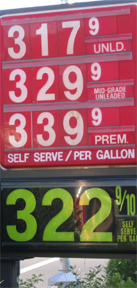
 In May
and June 2004, Geotimes ran stories about rising fuel prices at the
pump — gasoline prices had reached an all-time high when not adjusted for
inflation. That high was $1.78 a gallon.
In May
and June 2004, Geotimes ran stories about rising fuel prices at the
pump — gasoline prices had reached an all-time high when not adjusted for
inflation. That high was $1.78 a gallon.
Gas prices hit a high mark in September, following hurricanes Katrina and Rita,
but have dropped as the offshore industry in the Gulf Coast recovers. Photo
courtesy of Lisa M. Pinsker.
In September 2005, the story was almost the same —
rising fuel costs concerned the nation — but at more than a dollar more
than the 2004 prices, gasoline actually came within 4 cents of reaching the
all-time, inflation-adjusted high of $3.11 per gallon, and briefly substantially
surpassed that mark.
On the surface, reasons for the high gasoline prices in September and October
2005 were the blows the energy sector took from hurricanes Katrina and Rita,
when oil and natural gas production shut down in the Gulf of Mexico, which supplies
35 percent of U.S. domestic oil production and 20 percent of U.S. natural gas
production, according to the Energy Information Administration (EIA). Furthermore,
many oil refineries, which convert crude oil into gasoline, home heating oil
and other products, were shut down for several days, with at least four remaining
closed for months after the hurricanes left the area.
How long these refineries may be down is “indeterminate,” considering
the extent of damages, and “we are still a ways away from restoring production
at many of the rigs,” John Felmy, an economist with the American Petroleum
Institute, told Geotimes in September. “We are likely months away
from running at full capacity.” Hurricane Rita was called by many the most
damaging storm ever to the energy industry, and together, the two storms left
at least 108 platforms completely destroyed and dozens more badly damaged.
However, analysts suggest more is driving the price increases, which were already
well above 2004 rates prior to the hurricanes. Crude oil prices nearly doubled
in a year, and were up $20 a barrel, or nearly 50 percent, from January to June.
Also putting pressure on an already tight system are continued political unrest
in important oil areas, such as Venezuela, Nigeria and the Middle East; the
Organization of Petroleum Exporting Countries’ (OPEC) continued quotas
on exports; and ever-rising demand from China, Asia and the United States.
Worldwide petroleum demand growth continued at about 1.7 million barrels per
day of oil (above 2 percent) in 2005, according to EIA, but production increases
(supply growth) were only about 0.7 million barrels per day. Supply growth is
not keeping up with demand. The obviously stressed world energy market could
not afford the additional stress from the hurricanes, according to Cambridge
Energy Research Associates (CERA). “The Katrina-induced supply shock laid
bare how tight the global refining market had become,” CERA said in a statement
Sept. 16.
No new refineries have been built in the United States since 1976. In the weeks
following the hurricanes, however, Congress began looking at ways to lower gasoline
prices, including providing incentives to energy companies that would build
new refineries. A House bill, which was sent to the Senate Oct. 17, included
such incentives as a streamlined licensing process, reduced environmental regulations
and tax breaks.
The House and Senate also looked at ways to increase oil and gas production,
including drilling in the Arctic National Wildlife Refuge (ANWR) or offshore
on the outer continental shelf. While the Senate voted to allow exploration
in ANWR and is considering offshore provisions, the House rejected both options
in its budget reconciliation bill. A conclusion was still pending as of Nov.
15.
The rash of energy policy activity in Congress came just two months after President
Bush signed the energy bill — the first in four years — into law.
Legislators were quick to trumpet the bill’s passage as a testament to
bipartisan cooperation, filled with notions that will help the nation’s
long-term energy concerns. At the same time, they reminded the public that the
provisions in the bill may help stabilize the energy sector in the long term,
but is unlikely to change their electricity bills or save them any money at
the gas pump in the short term.
To address short-term energy concerns, President Bush has called for greater
conservation. He joined industry analysts and environmental groups in reminding
the public to drive less — take public transportation, carpool or combine
errand runs — have their cars finely tuned, and drive more modestly, which
increases fuel efficiency. Ultimately, however, no matter what legislation comes
out of Congress this year, Felmy said, what controls gasoline and oil prices
is largely simple economics: supply and demand.
Megan Sever
Links:
"At the pump," Geotimes,
May 2004
"At the pump, part II," Geotimes,
June 2004
"Katrina strikes the energy sector,"
Geotimes online, Web Extra, Sept. 9, 2005
"Katrina blows in higher energy prices," Geotimes, October
2005 Print Exclusive
Back to top
For the first time in four years, Congress passed an energy bill, which President Bush signed into law Aug. 8 (see Geotimes, September 2005). Some key provisions in the $12.3 billion legislation include:
During conference, House and Senate leaders dropped the most contentious parts of the bill. The final version included no provisions for drilling in the Arctic National Wildlife Refuge, no liability protection for producers of methyl tertiary butyl ether (MTBE), and no renewable portfolio standard.
Links:
"Energy bill passes,"
Geotimes, September 2005.
 |
Geotimes Home | AGI Home | Information Services | Geoscience Education | Public Policy | Programs | Publications | Careers |